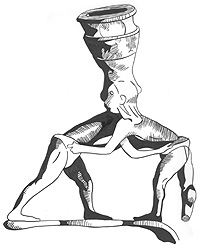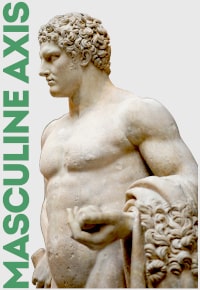After the death of Theodosius, the last emperor to take the saddle, his two degenerate sons, ascended to the thrones of The East and West. Honorious in the West was the caged dove of Stilicho, his artful minister. Honorius was married to a beautiful bride and, after 10 years was unable to make love to her, was unable to have sex, had no desire other than feeding birds. His younger brother, Archadius was managed by a rapacious minister who looted the Eastern Empire in an attempt to have his daughter married to Archadius. Saved by Stilicho, tyrant of his older brother, Archadius would die in palatial obscurity.
The Moorish Civil War
The 7 leading legions, including the Jovians and Herculeans, once 5,000 strong, reduced to 1500 strong in the late 200, were now in the final decade of the 300s reduced to a force of only 5,000, seeing a seven-fold reduction in strength. This war ends in the maiming or death of one standard bearer.
Thrice the minister of Honorius, Stilicho, defeats and encircles Alaric and his Goths, to have the Gothic king and his men slip away. Gibbon considers that the two men, with informers in each other’s mercenary camp, are in some kind of communication.
Stilicho, the Roman Christian, attacked Alaric and the Christian Goths on Easter Sunday, entrusting the battle to a pagan Goth, unnamed by history, who fell in the attack! This seems to have been a bloody battle, with the Gothic camp captured at Polentia. The last combat of Gladiators in Rome was given after the driving of the Goths away from the palatial retreat of the emperor at Milan in Northern Italy. Gladiators were used in Syria by fanatic monks to wipe out pagan temples and slaughter pagans. In 404, Telemachus, an Asiatic monk, went into the arena to stop gladiatorial combat, was stoned by the mob and percipitated the final enforcement of the Theodosian Code that forbade all pagan rites.
Honorius, who in 28 years as emperor, did nothing but shelter in place and evacuate to a safer shelter, was the archetype of the captive puppet monarch. Ravenna, on the shores of the Adriatic, became the last refuge of the effete Roman emperors, was a naval base, military supply depot, a city of canals surrounded by vineyards, which still throve in Gibbon’s day. This city had a better supply of wine than water.
The Chinese annals reveal the secret and remote causes of the fall of Rome, which was the rise of the Tartars who drove west the Huns with their own methods and held Northern China for a time until one of these Tartars went over to China and conquered from Korea to the Caspian Sea, defeating the Huns and Alans and sending them west into Eastern Europe. The fugitive Sarmations drove out the Swabians, Vandals and the Burgundians, who were joined by the horseman of the Alimani “Allmen” who were the residue of various German tribes wiped out by the earlier Roman power. These were lead by Radigast, king of the confederate Germans. Much of Northern Italy, already taxed into poverty by the civic structure of Rome in the 300s, were now pillaged. The incompetent siege of Florence marked the birth of that city as a republic of the Middle Ages, as recalled by Machivelli. Radigast was a hero king campaigning under Thor and Odin. This desperate invasion was stopped by Stilicho with an army raised by the following means:
In A.D. 406 a law offering 2 pieces of gold to any slave who would enlist in the legions, permitting Stilicho to “painfully collect,” an army of only 30,000 men, compared to the much larger armies of Volunteers in the 300s B.C. These were combined with a large force of German mercenaries.
Stilicho besieged the besiegers of Florence as he had numerous times the Goths under Alaric. Radigast was beheaded and his starved warriors were sold at 1 gold piece each, and most died quickly. Something like 100,000 of these Germanic refugees from the Baltic scattered about Italy and Gaul. [1] The invaders fought the Franks, who defended the empire. 20,000 Vandals were slaughtered by the Franks, their survivors rescued by the Alans, the blond horsemen out of Asia who Arrian fought about A.D. 130, and had recently intermarried with the Huns, both driven west by the Tartars.
“Smoking ruins alone demarcated the solitude of nature from the desolation of man.”
The last legions had been recalled from the Rhine and Britain a decade earlier to satisfy the needs of civil war. It seems, that despite the use of the stirrup and the introduction of the pressure of the Huns from out of the hinterland, that the Germanic peoples were still hard put to finish off the Roman Power that had for 400 years ravaged the German nations. It seems that Alaric’s demand, when he was comically given a military post in the Eastern Empire after ravaging Greece, devoted his Roman authority to having Roman factories produce shields, spears and swords for his men. These, it is surmised were used to arm poorly equipped able-bodied men yet in German territory.
It does seem that Scotsmen from Ireland invaded what was left of Roman Britain. The remaining garrison elevated a Marcus as king and then killed him, then a Gratian was crowned and killed by these rear echelon soldiers. They then elevated a common soldier named Constantine, who was wise enough to realize he would be murdered in Britain and invaded Gaul. This marks the motivation of the British soldiers as a desire for plunder of the falling empire. Constantine, being a common thug, did better than his predecessors until he became the target of the imperial army. Constantine managed to invade Spain at the head of a mongrel 9,000 man host including Germans, Gauls, Moors and Scots, slaughtering an army recruited from slaves by the descendants of Theodosius. This Common Constantine fled perfidious Britain and grifted his way to rule of Gaul and conquered Spain with a mob of pirates and bandits. The bones of Rome were being picked over.
Alaric, once the Master General of Eastern Rome, renounced that title and became Master General of the Western Empire. Alaric played the fence and seems all along to have been in league with his foe and friend in conspiracy, Stillicho, both of them leading armies that teamed with conspirators eager to kill them for gain. Victory had at too high a cost could coast one his head at the hands of a rival from his own army. Alaric now pressured Stilicho for more benefits in order to march against Constantine. The many “dark transactions” of power players picking over the ages of hoarded Roman treasure, is very similar to the scheming, looting and double-crossing of the pirates of the early 1700s.
Finally, sycophants and women about Honorius, who had been the actual prisoner of Stilicho for decades, directed him to murder the friends of Stilicho, the eight or so richest and most powerful ministers of the West, including the four top military commanders. Since the 180s, some 220 years earlier, this had been the Roman way, not changing a bit under Christian faith, to wipe out the political opposition by murder, to disable political retribution while looting their personal fortunes and murdering their wives and children. Roman politics in Late Antiquity had become some what more than the squabbling of pirates and something less than the feuding of drug cartels. This massacre at Pavia saw Honorius, naked and trembling without his regalia, wandering the streets in a state of recompense, having given in to his “favorites” in a conspiracy that seemed to be more about loot than power. Again, the sinking ship of Rome was a battle between sailors and rats over the last scraps of food, rather than some revolution motivated by faith, hate or even power.
In Bologna, Stilicho assembled his war chiefs, who insisted on marching to Pavia and avenging this insult. Stilicho hesitated, with distrust of his barbarian allies. Carus, a mighty Goth, invaded Stilicho’s camp, “cut in pieces the faithful Huns who guarded his person,” and got into the Minister’s tent. Stilicho, managed to escape the Goths, then warned Italy to shut the gates of the cities against his former instruments, and fled to Ravenna, having committed three patriotic acts in as many days, something unlikely to be forgiven by cruel Fate, even as she glared from behind her Christian veil.
What seems to have been Stilicho’s immediate undoing, was a sudden, rare, and now consistent interest in preserving the remains of the race and culture he had compromised across a career of self-interest and practical power politics.
Stilicho sought refuge in the Church of Ravenna and was lured fourth and executed on the steps of the Church, at his final hour, honoring former Roman generals by dissuading his supporters from civil war and giving his neck to the blade. Maniacal church ladies, such as Olympias, were now thick into the murderous politics of torture, rape and child murder at Ravenna, now placing the Christian but still barbarian Goths, in the moral ascent. Also, the infrastructure of military management had now been gutted for good. Rome, to the extent it existed in the East and the West, would be increasingly dependent on barbarian men and methods.
Stilicho, had only enough virtue left in him to assure his own demise, last of the skilled military men to serve his nation with a shred of conscience. Any praise of this slain minister, who got rid of no fewer than four barbarian armies from Italy, was, by law, punishable by death. The death urge of the collective Roman mind was in the ascent.
The “peculiar merit” of Claudian, the poet and chronicler of these sorry episodes, is addressed in an extensive footnote by Gibbon in a compassionate balance of criticism as the closing statement on the fall of Stilicho.
Notes
-1. Gibbon notes that he was composing this section of his work in 1777, and had been working on the section since 1771, demonstrating that the context of this project was his involvement in British Imperial Government at the very time that empire was fighting to maintain the bulk of its imperial possessions, in America.











